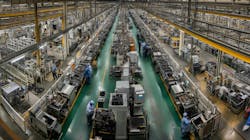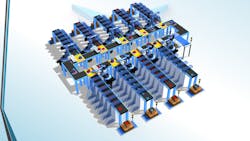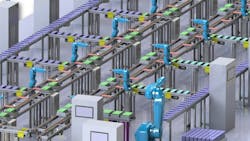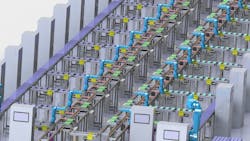Moving from Sequential Assembly to Parallel Process Technology Delivers 50% Cost Reduction
- Vivet Technology's Repeating Layer Process (RLP) replaces traditional sequential assembly lines with simultaneous production steps, eliminating bottlenecks and enabling manufacturers to scale capacity up to 20 times without additional floor space.
- RLP delivers system availability of 92-99%, while cutting design and setup time nearly in half for faster time-to-market.
- Built on Siemens automation technology including virtual PLCs and digital twin simulations, RLP provides real-time adaptability, seamless machine communication, and cloud-IIoT connectivity that enables manufacturers to optimize operations before physical deployment.
For more than a century, traditional assembly lines have driven mass production across industries. By breaking down complex manufacturing into sequential tasks, manufacturers could scale efficiently — at least within the constraints of their linear models.
But as demands for greater flexibility, scalability and cost efficiency grow, manufacturers are confronting the limits of this approach.
Rethinking the production paradigm
Traditional manufacturing innovations mostly focus on machine-level improvements that increase the speed, size and task capacity of individual machines. While these offer incremental efficiency gains, they often fail to address systemic bottlenecks that limit overall throughput.
To address this, Vivet Technology developed what it calls the Repeating Layer Process (RLP) that can be used to optimize entire manufacturing processes rather than just individual machines.
Unlike traditional assembly lines, RLP is built on a parallel processing model, using an algorithm that allows multiple production steps to occur simultaneously rather than sequentially. This modular design eliminates traditional bottlenecks, improves system availability and allows manufacturers to scale operations incrementally, adapting to fluctuating demand with minimal disruption.
The company’s first three iterations of the technology didn’t work, so they spent time rethinking how production data was processed and controlled until the needed results were achieved. Vivet spent more than three years building and validating the algorithm.
However, as the system architecture took shape, another hurdle emerged: ensuring RLP’s computing and control infrastructure could handle the complexity of a parallel processing model at an industrial scale.
Building out RLP’s features and functionality
Once Vivet’s engineering team had validated RLP as a scalable manufacturing model, they faced the challenge of implementing it in real-world production environments.
With RLP’s parallel processing model, manufacturers can increase production volume by as much as 20 times by adding more layers to the system — without requiring additional floor space or expensive structural changes.
Because conventional manufacturing control systems weren’t designed for RLP’s level of real-time data processing and synchronization, the RLP system required controls that could provide high-speed processing, seamless machine-to-machine communication and real-time adaptability.
For the core of the RLP’s control system, Vivet chose Siemens’ Simatic S7-1500 PLC, a controller capable of processing the complex algorithmic calculations that drive the RLP’s dynamic production flows. But the biggest impact on RLP’s development came from the use of Siemens virtual PLC technology, which provided data safety, security, encryption, industrial fail-safe functionality and real-time performance for RLP.
Unlike conventional, hardware-dependent PLCs, the Siemens virtual PLC allows Vivet to commission RLP systems on the Siemens Industrial Edge platform much faster, scale them more efficiently and introduce updates without disrupting operations. Deploying the RLP’s automation and control functions via a software-based, fail-safe architecture at the edge enables cloud-IIoT data interactions. It also facilitates OT/IT integration, whether it’s used on the plant floor or enterprise wide.
Visualization, monitoring and control
Along with the physical and virtual PLCs, Vivet deployed the Siemens Simatic WinCC Unified System HMI/SCADA platform. This web-based, scalable architecture enabled Vivet to build a user-friendly interface that connects operators, machines and the RLP algorithm.
This addition allowed Vivet engineers to develop RLP’s core set of features and functionality just once and reuse them as needed for most of its customer requirements, even those in different manufacturing sectors. This is a crucial element for Vivet, because it wanted the RLP to use one standardized, open system for everything from process visualizations to horizontal machine integration to vertical system integrations, regardless of applications or target equipment and systems.
Programming of RLP was done using the Simatic TIA Portal, as the RLP algorithm requires the high-speed processing of many complex mathematical calculations as well as dynamic memory manipulation. The TIA Portal enabled Vivet to share user data types between the PLC and HMI, which simplified the design and communication schemes, allowing the engineers to focus on the performance and efficiency of the RLP technology rather than the capability of the platform.
To further refine and optimize RLP’s implementations, Vivet engineers use Siemens Tecnomatix digital manufacturing software. This enables them to build digital twins of customers’ production processes, including the modeling, simulation, analysis, visualization and optimization of material flows, as well as assembly and logistics operations.
Deploying the RLP’s automation and control functions via a software-based, fail-safe architecture at the edge enables cloud-IIoT data interactions and facilitates OT/IT integration.
Tecnomatix software lets Vivet engineers simulate nearly any manufacturing scenario, identify potential bottlenecks, and optimize resource utilization before physical deployment. That saves Vivet and its customers months of time and enormous costs compared to physical validations that would otherwise be needed.
Quantum gains in output and reductions in unit costs
In the early development of RLP, everything was done with mathematical formulas. But once the RLP prototype was built and deployed in a physical environment, Vivet found the performance gains over traditional manufacturing models were even greater than anticipated.
In early simulations, Vivet estimated RLP could reduce production costs by at least 20% compared to conventional assembly lines. After integrating and optimizing the Siemens automation and controls stack using Simatic WinCC Unified, it became clear that a 50% reduction in cost per unit was not only possible but sustainable.
The ability to scale RLP without encountering bottlenecks proved to be one of its most significant advantages. In traditional manufacturing, expanding capacity often requires either investing in entirely new production lines or making costly retrofits to existing infrastructure. However, with RLP’s parallel processing model, manufacturers can increase production volume by as much as 20 times by adding more layers to the system — without requiring additional floor space or expensive structural changes.
Unlike traditional assembly lines, RLP is built on a parallel processing model, using an algorithm that allows multiple production steps to occur simultaneously rather than sequentially.
High system availability of between 92% and 99% drastically reduces downtime, ensuring consistent manufacturing operations and more efficient use of resources.
In addition to these big production gains, Vivet’s RLP technology can provide manufacturers with:
- Space efficiency: Manufacturing facilities using RLP can operate with 50% less real estate, allowing for more streamlined and compact factory layouts.
- Faster time to market: RLP reduces design and setup time by nearly 50%, allowing manufacturers to respond quickly to market demands.
- Dynamic memory allocation and industrial edge platform allow the system to scale efficiently without interrupting operations.
- Higher product quality: Extended cycle times enabled by RLP enhance quality control by allowing for longer durations of quality operations, leading to an overall improvement in the quality of the final product.
- Reduced equipment complexity: By leveraging technological efficiency, the process allows for the use of off-the-shelf equipment. This reduces the necessity for custom-built equipment while ensuring consistent output quality.
More manufacturing productivity insights from Automation World:
How Diverse Manufacturing Industries Can Benefit from RLP
Although initially developed for EV battery production, RLP’s scalable, system-wide approach applies to a wide range of industries that require high efficiency and rapid scalability. Among the sectors positioned to benefit from RLP are:
- Battery cell, module and pack assembly systems.
- Semiconductor and chip manufacturing.
- Electronic board manufacturing.
- High-mix, high-volume production in consumer products and custom manufacturing.
- Pharmaceutical production, especially for packaging and bottling.
- Food and beverage production.
- Medical device assembly.
- Defense manufacturing.
About the Author

Leaders relevant to this article:



